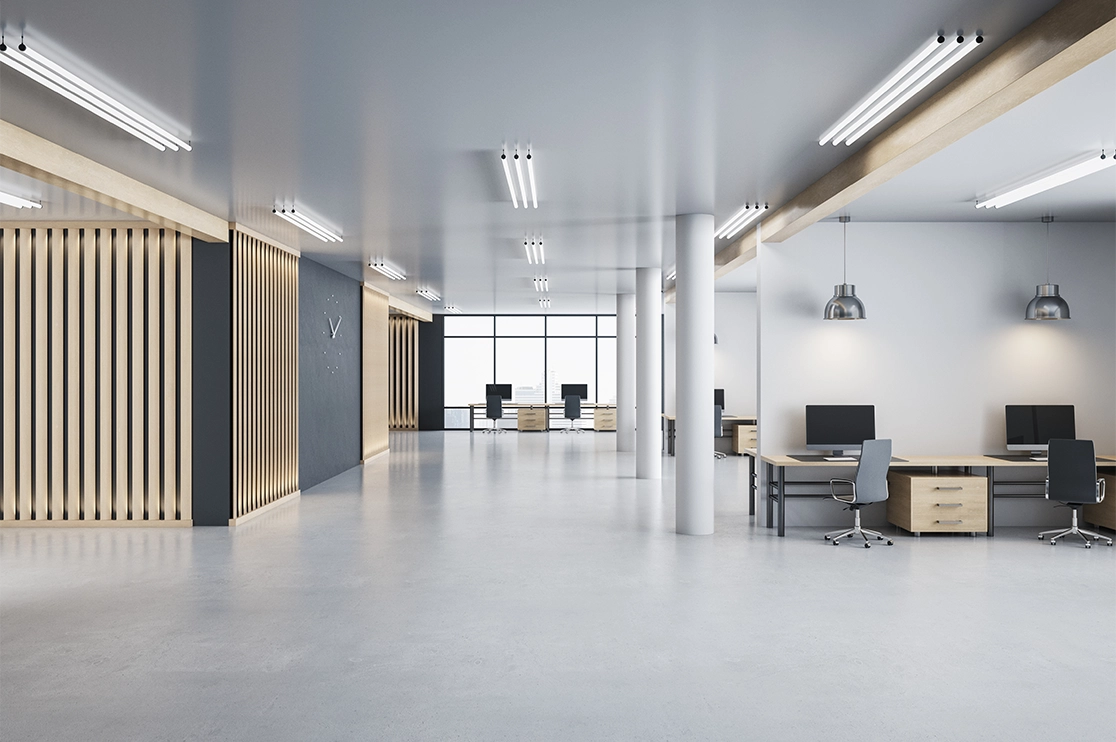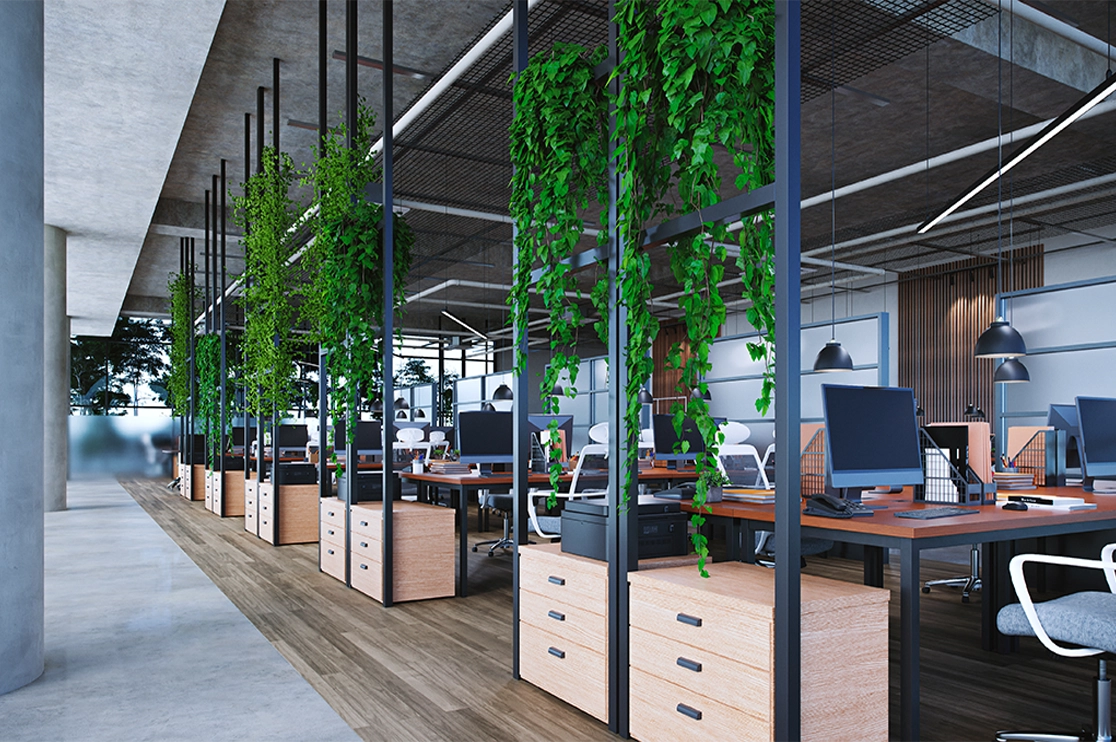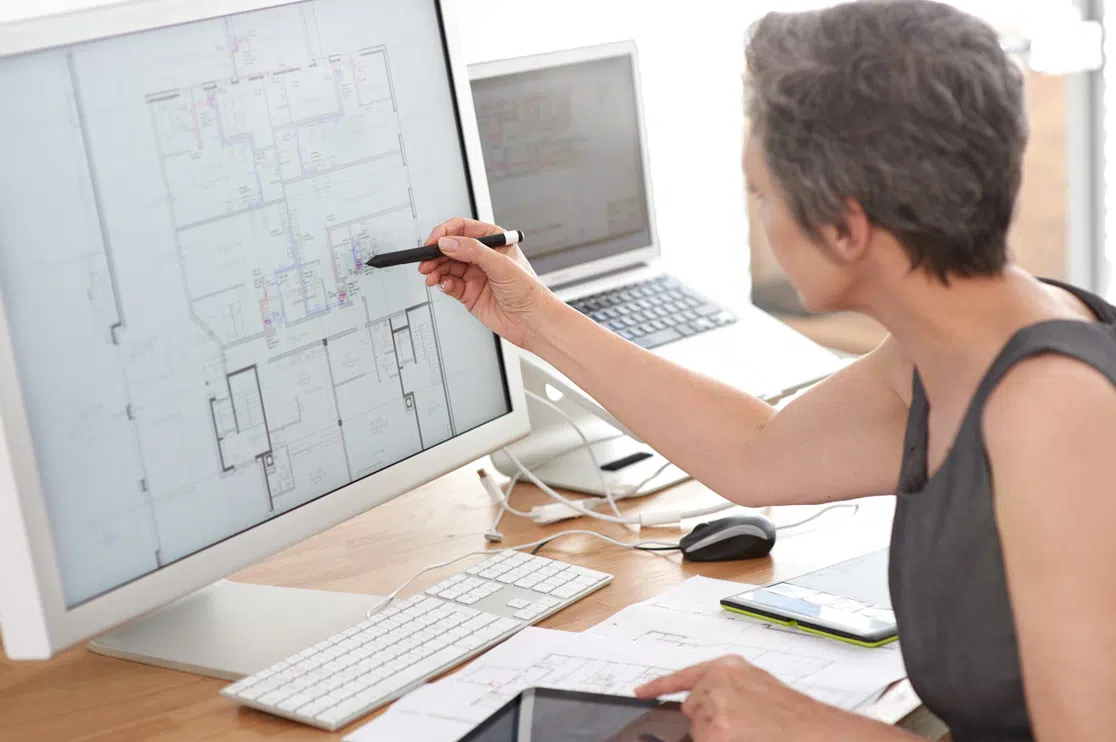There is no one-size-fits all approach to office building design, but there are certain elements that are commonly found in successful commercial spaces.
You want to attract and retain the best people, and modern office design is all about well-being, safety, productivity, and community.
We’ve compiled some of the most effective elements of commercial building architectural design to boost your business’ productivity and retain the best talent.
Table of Contents
Introduction: The Necessity of Good Office Building Design
Do you face stiff competition for the top talent in your industry? Is your staff turnover rate too high?
One reason might be your office interior design. These days, financial compensation is just one part of what employees want. They want a workplace that facilitates communication, focus, serenity, health, and creativity.
Modern office design should tick off all those.
Top Elements of Office Design
1. Sensible Office Layout
People will get disturbed by noises and smells, so don’t place desks right next to kitchens, pantries, toilets, or frequently used photocopiers. Try to create a peaceful, clean, and quiet environment. Good interior construction drawings will also be essential for this.
2. Accessibility
This should be non-negotiable.
The ADA mandates that various new constructions be accessible. You can find the minimum requirements in the ADA Standards for Accessible Design. Having said that, you should attempt to fulfill all the requirements.
Here are some of the key requirements:
-
Accessible routes, entrances, and parking that can accommodate wheelchairs and persons with various disabilities. This also means that your office furniture should be placed at least 32 inches away from walls and other objects to allow for proper wheelchair mobility. 60 inches clearance is required for wheelchairs to rotate and turn at corners.
-
Accessible bathing spaces and toilet rooms as required by the ADA.
-
Accessible workstations and countertops. This includes adjustable desks, modifiable work surfaces, and desk height between 24 and 36 inches. Employees should not have to reach below 15 inches or above 48 inches.
-
Assistive technology.
Additionally, you should ensure that you meet web accessibility standards.
3. Spacious Office Design
Avoid rows of desks with less than a meter between them, cupboard-sized offices, and other cramped layouts. You may be able to squeeze in more workers, but you’ll get lower productivity, as they will be distracted and unhappy. If you’re strapped for space, you can consider desk clustering.
4. Proper Flow
Ensure that workers can move from task to task without being hindered by convoluted paths and piles of desks and boxes. A good flow will also provide the illusion of a larger space, helping your employees to feel less cramped.
5. Fresh Air and Natural Light
As much as possible, do not let your employees feel stressed and sluggish. You can prevent this by ensuring they get ample fresh air and sunlight, which will impact their moods and productivity.
-
Open the windows, which regulates moisture and oxygen
-
Air conditioning in airless rooms leads to low oxygen levels and dry air, which cause tiredness and dry eyes
-
If you do not have windows, use glass paneling instead of opaque partitions
6. Color Psychology
Colors can have a notable impact on moods, so make sure you check out the best color choices for commercial architecture projects. It may seem insignificant, but a little attention to your office building design goes a long way.
7. Quiet Zones
Especially if you have an open office plan, make sure that you allocate areas for silence. Open-plan offices can be noisy and disturbing, so provide rooms where workers can sit if they have a task that requires focus and quiet.
8. Break Facilities
When was the last time you worked well when your brain was fried?
Install a separate break area where workers can relax with a cup of coffee. A good quality break – with a change of visual stimulus and a rested mind – can lead to a rise in productivity.
9. Health and Comfort
Badly designed furniture isn’t about it being an eyesore – it’s about it having a negative effect on your employees’ health and productivity.
If your employees are in pain or uncomfortable while working, you can’t expect them to give you their best work. Hence, ensure that you have ergonomic furniture, especially chairs.
Additionally, your office should be neither too cold nor too warm. Don’t keep the air conditioning or heaters permanently on. Take into account that women have lower metabolic rates than men and tend to get colder more easily.
Ideally your office temperature will be between 68 and 76 degrees Fahrenheit (20 and 24.4 degrees Celsius), but this is not a hard and fast rule.
You may also want to consider acoustic design for a more serene environment.
Recommended Reading:
10. Biophilia
Identify the equipment you will need, such as pallet racks, lifting and packing tools, and conveyors. This will help you design the most suitable warehouse layout for your requirements and hence boost your productivity.
11. Flexible Workspaces
A flexible workspace involves tables, chairs, and desks that are easily resizable and movable. It will utilize modular furniture and perhaps unassigned seating arrangements. That is, employees can sit wherever they please. This may enhance performance and collaboration.
In contrast, a traditional office plan includes furniture and other resources that are unchanging and fixed.
12. A Home Away From Home
There’s a trick that fine dining restaurants use to gently encourage customers to stay seated and purchase more food: a comfortable, welcoming environment.
If you make your office relaxing, your employees are more likely to stay. Common perks you can add include armchairs, pod seats, lounge areas, coffee tables, a sack bar, balconies, outdoor terraces, bicycle storage, showers, and even a gym.
13. Urban and Site Planning
When choosing your office location, consider the travel time for the majority of your employees. Most people do not enjoy long transits, and are already tired by the time they reach their office. Furthermore, you should bear in mind housing costs, traffic, crime rate, civic infrastructure, and natural attractions such as mountains and riverfronts.
Additionally, the long-term performance of your businesses should be optimized through monitoring, metering and reporting. This feedback should be given to maintenance operations.
Last but not least, consider previously developed structures rather than constructing a new building. This will reduce the environmental impact.
Recommended Reading:
Conclusion
We hope this article has given you a starting point for an office building design that will suit your business needs and boost productivity.
When constructing or renovating a commercial building, accurate construction documentation is a must. BluEntCAD serves homebuilders, architectural companies, engineering companies, real estate developers, and home designers for large to medium sized commercial, hospitality, infrastructure and residential projects.
Ready to make your modern office design a success with construction documentation services? Contact us now!








 Must-Ask Questions Before Outsourcing CAD Drafting Services
Must-Ask Questions Before Outsourcing CAD Drafting Services  How BluEnt Ensures Construction Documentation is Accurate and Up-to-Date?
How BluEnt Ensures Construction Documentation is Accurate and Up-to-Date?  Why CAD Drawings Are Crucial for Sustaining the Modern Architecture Industry?
Why CAD Drawings Are Crucial for Sustaining the Modern Architecture Industry?  How is Artificial Intelligence in Construction Design Transforming Architectural Landscape?
How is Artificial Intelligence in Construction Design Transforming Architectural Landscape?